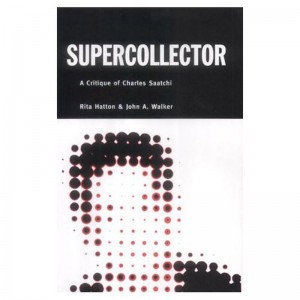 Charles Thomson reviews the unexpurgated life story of Charles Saatchi.
Charles Thomson reviews the unexpurgated life story of Charles Saatchi.
“Ad man you’re a bad man”, proclaimed the artist collective Bank bluntly about Charles Saatchi in 1997. In 2004, Guardian art critic, Adrian Searle, praised Saatchi’s popularist approach, eye and humour in his New Blood show, but drubbed the curatorial incoherence. Sir Peter Blake has refused to sell his work to Saatchi because, “I formed the opinion very early on that he wasn’t collecting for the love of art”. Victoria Miro commended Saatchi’s “passion for looking at art”, and Jonathan Jones of the Guardian lauded Saatchi’s “empathy for youth” and his “obsession with the contemporary”, while an anonymous writer in Art Review (actually David Lee, its then editor) wrote him off as “a commodity trader in art futures”.
Virtually anything Saatchi has done has had vociferous detractors and supporters, though probably more of the former than the latter, especially as the years have gone on. Their views are assiduously documented by Rita Hatton and John A. Walker in the book, Supercollector: A Critique of Charles Saatchi, which first appeared in 2000, a time when Saatchi was firmly ensconced as the all-powerful YBA Machiavelli, a click of whose fingers were deemed to signify fame and success or the artistic rubbish heap. New editions were published in 2003 and 2005, each adding extra chapters to update the story.
The fourth edition (Institute of Artology, £25) now out has more than doubled the dimensions of the original, with nearly 30% more pages and bigger type size. In the intervening decade so much has changed that Walker informs me: “I do not think I will do another edition about Saatchi because I am bored by him now and I think he has lost his novelty value.” Saatchi seems to be in general agreement with this (not quoted in the book): “I certainly was more dynamic once, building my advertising business and my art collection with ferocious energy. Now that I have fizzled out, I still enjoy putting on shows of art that I like and introducing new artists to our visitors, so I hope it makes it worthwhile to plod on.”
It is primarily the ferocious energy phase that Walker and Hatton take issue with, declaring on their book’s back cover that they are writing “a hostile critique from an anti-capitalist standpoint”, the text quoting Marx, not to mention Baudrillard, Bourdieu, Veblen and Raymonde Moulin to reinforce the case. The anti-capitalist stance also embraces anti-consumerism, anti-advertising and anti-Conservatives (but fortunately not anti-Art). Walker, raised in the working class but university educated and now retired on a small pension, has stated bluntly elsewhere in an interview with Robert Orman, “As a painter and art critic myself, I do resent and envy the power Saatchi exercises in the field of art because of his money.”
 Ironically, although he and his brother Maurice at one stage ran the world’s biggest advertising agency with 400 offices, 10,000 clients and 11,000 employees, Saatchi, albeit from a middle class background, was educated in a state school (Christ’s College, Finchley) and left education age 17 with meagre qualifications and poor spelling abilities. The factual narrative, which comprises most of the book, details his entry into advertising and the growth of the brothers’ business, along with his increasing focus on art, though it does not illumine exactly how the Saatchis managed to achieve such business success, nor point out that it was potentially achievable by anyone who made it their goal and had sufficient acumen and driving force.
Ironically, although he and his brother Maurice at one stage ran the world’s biggest advertising agency with 400 offices, 10,000 clients and 11,000 employees, Saatchi, albeit from a middle class background, was educated in a state school (Christ’s College, Finchley) and left education age 17 with meagre qualifications and poor spelling abilities. The factual narrative, which comprises most of the book, details his entry into advertising and the growth of the brothers’ business, along with his increasing focus on art, though it does not illumine exactly how the Saatchis managed to achieve such business success, nor point out that it was potentially achievable by anyone who made it their goal and had sufficient acumen and driving force.
Regardless of what one thinks of Saatchi, a cumulative effect of the book’s narrative is to convey the staggering amount that he has achieved, particularly in terms of the variety and number of shows and artists bought (and sold) and exhibited over the years. By 2004, he owned 2,500 artworks with a value of around £50 million. The book clearly makes the link between the ephemerality and superficiality of advertising and the same quality in much of the work Saatchi promotes, but then even Saatchi himself admits that 90% of it will be worthless in ten years time (and it was ever thus). The incorporation of quotes from more recent interviews given by Saatchi reveals even more his maverick, independent and dissenting nature. He is paradoxically a stand-alone art establishment and at the same time highly critical of the art establishment in general, especially its “arid intellectualism”.
One of Walker and Hatton’s most potent judgments is “When one man decides everything, democratic control and accountability diminishes and the arts become over-dependent on the whims of an individual.” However, their alternative suggestion that “Improved state funding of art schools and public museums would have prevented much damage from taking place” is less convincing – especially when the policies of the Arts Council and the Tate are considered – than Saatchi’s contention that without rich collectors “the art world would be run by the state, in a utopian world of apparatchik-approved, culture ministry sanctioned art.” Surely, what is lacking is a number of independently minded major collectors with different agendas, but who, as the late Tom Lubbock pointed out about Saatchi, are “out on a limb, not worrying about mockery, exposing the curator’s taste nakedly to the world” – something which is hardly likely to occur in the public sector.
If, as Patricia Bickers opined in Art Monthly in 1997, “Saatchi’s dominance does not merely support, but possibly distorts, the nascent market” (by basically disadvantaging smaller competitors), then there is a mechanism via the Office of Fair Trading under the Competition Act to address this. I made such a complaint with fellow Stuckist artists and others in 2004, but it was not upheld. Walker and Hatton, gratifyingly albeit not surprisingly, consider that there was a valid case to be addressed.
Saatchi is now a more benign figure, “greyer and wiser” (Charles Darwent in The Independent on Sunday), and even Walker and Hatton concede that “as Saatchi grows older he appears to [be] becoming more discriminating in his value judgements.” (I don’t think they were being ironic.) It is hard to fault his decision to open up the website http://www.saatchi-gallery.co.uk to any artist who wants to upload a page of biography and images of their work, which they can then sell free of commission. So far over 120,000 artists have taken advantage of this. It has of course been faulted, notably by Jackie Wullschlager, the Financial Times critic, for “turning art into a virtual encounter rather than the imaginative, transcendent, lived aesthetic experience it has always been.” So there you go: it’s all Saatchi’s fault that art is on the internet. He’s a bad man.
http://www.artdesigncafe.com/SUPERCOLLECTOR-A-Critique-of-Charles-Saatchi-4th-ed
http://www.saatchi-gallery.co.uk/
The Jackdaw Jul-Aug 2011

